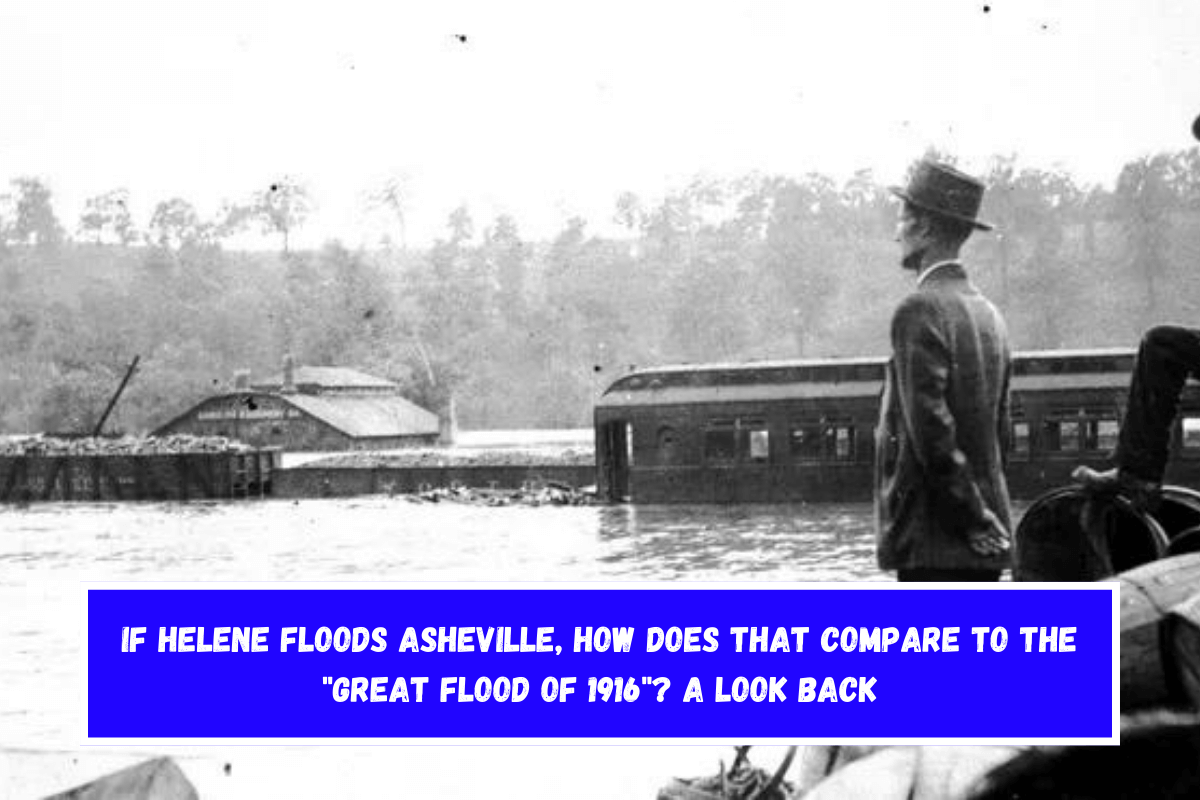North Carolina is trying to get back on its feet after the terrible effects of Tropical Storm Helene. Help is on the way. Communities around Asheville and in the western part of the state were hit hard by the storm. Homes were destroyed and bridges fell down.
As of Monday, 35 people had died, but that number is likely to go up.
More than one hundred years ago, Western North Carolina was hit by another terrible and deadly flood. This one was caused by Helene. The flood of 1916, which was caused by heavy rain from a series of storms and was called the “Great Flood,” caused unimaginable damage.
“It was more than a universal cloudburst in all this mountain country,” the Newton Enterprise wrote on July 25, 1916. “It was a night of tempest and terror.”
Let’s remember the “Great Flood of 1916.”
North Carolina’s ‘Great Flood of 1916’: The ‘worst natural disaster in the recorded history of Western North Carolina.’
There was rain for weeks on end, and then it turned into “the worst natural disaster in the recorded history of Western North Carolina.” The terrible North Carolina flood of 1916 caused a lot of damage and killed a lot of people. It also destroyed roads and railroads.
The National Weather Service says that on July 5, 1916, a storm system hit land in Alabama. It then rained heavily and nonstop over the foothills and mountains of North Carolina. The first storm didn’t cause any flooding, but the ground got very wet and pools of water were running high.
Then the second storm came through.
A Category 2 storm hit land on the coast of South Carolina on July 14. On July 15, it hit the mountains in North Carolina. It rained a lot, setting records. It is said that 22.22 inches of rain fell in parts of Western North Carolina between July 15 and 16.
Then there was deadly destruction.
“The French Broad river, which flows through Asheville and west into the Tennessee river, crested an estimated 17 feet above flood stage,” said the weather service. “Even higher readings, up to 23 feet above previous high water records, were recorded along the Catawba River, which flows out of the mountains southeast to near Charlotte and into South Carolina.”
“Destruction and loss of life was widespread along both rivers.”
As the Asheville Citizen-Times said before, storm currents tore babies from their parents’ arms and landslides killed whole families. At least fifty people were dead when the water went down. Where fields used to be, only a thick, black sludge was left.
The flood killed 80 people in total, but the exact number of people who died will probably never be known. There were a lot of destroyed houses, factories, railroads, and bridges. The damage was put at about $22 million, which is more than $600 million today.
How does the flood from Helene compare to the ‘Great Flood’ of 1916?
From 1916 to 1917, the Winston-Salem Journal said that the flood damaged property worth millions of dollars. The damage to crops alone was worth several hundred thousand dollars.
Almost all of the steel bridges that were just built were destroyed or washed away. A tobacco warehouse, a hotel, and several other buildings and houses were flooded in Elkin, according to the Winston-Salem Journal. This is where the most damage was done to property. Several cotton mills in Catawba were destroyed.
The Winston-Salem Journal wrote, “It is safe to say that no such damage has ever been caused by flood in the western half of North Carolina.” “Indeed, no one thought this section of the state could ever suffer such damage.”
There are reports that about 80 people died in the 1916 flood, but the real number is thought to be higher. The Statesville Record and Landmark says that more than 20 people died when a single bridge at Catawba gave way. The victims included 14 railway workers, 4 telegraph workers and six people who were just watching.
Today, the western part of North Carolina is also being hit by damage.
Mike Morgan, a spokesman for Henderson County, said it was “the worst storm damage” he has ever seen.
Asheville is north of the small, historic town of Marshall. Some city buildings were flooded to the first floor. Marshall is near the French Broad River. Other businesses in the downtown area that have become part of an artistic renewal in recent years were also destroyed by the flooding. The damage also reached a water treatment plant across the river.
In Asheville, floods destroyed parts of Biltmore Village and other places. According to the NOAA, the Swannanoa River at Biltmore reached its highest point at 3:45 p.m. Friday, at 26.1 feet. This is almost 6 feet higher than the previous record. The river was only 20.9 feet high at 10:30 p.m. The previous high score for that spot was 20.7 feet.
Firefighters and first responders saved more than 100 people on Saturday in the Lake Lure and Chimney Rock area, where the storm had cut off phone and internet service.
Help is on its way, but it will take a long time to get back to normal because no one knows how bad Helene’s damage really was.















Leave a Reply